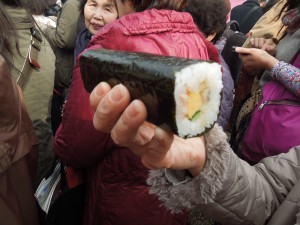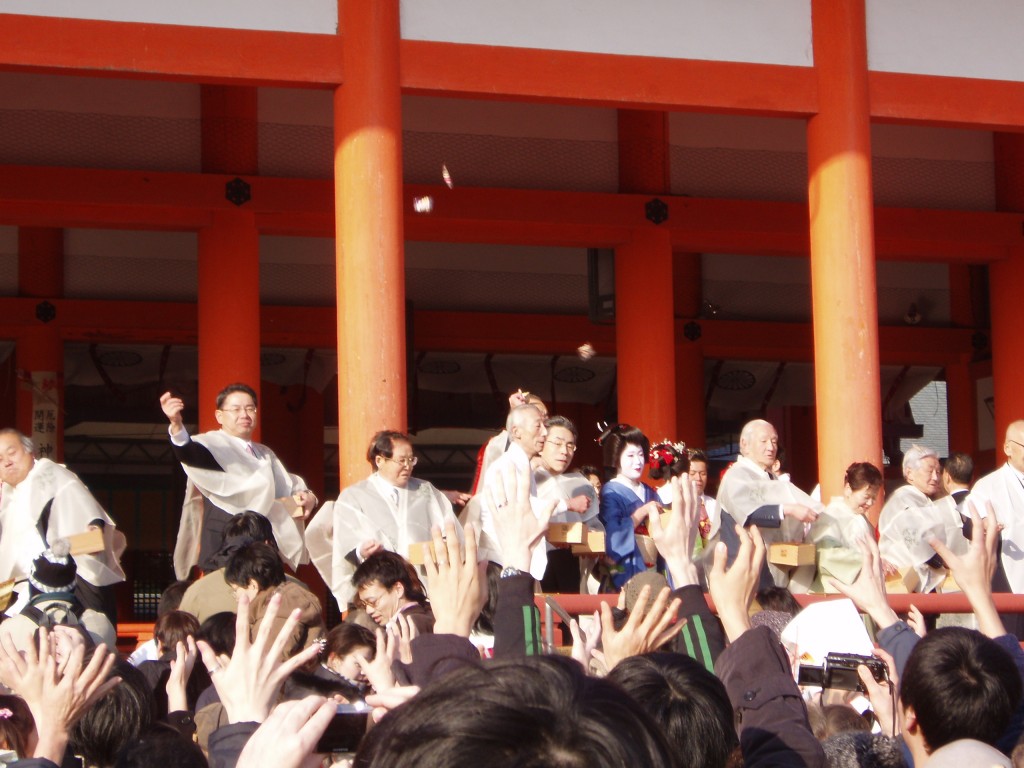
Shops have been doing a good trade in kits for domestic rites, when you get to throw beans at your family!
Yes, it’s that time of year again, when we get to look towards the promise of spring and try to rid ourselves of winter demons/ Here are five points of note about the seasonal festivity.
1) It’s traditional to gather up the scattered beans and eat the same number as your age, plus one for good measure.
2) The date is taken from the old lunar calendar. Because it needed tweaking to keep in alignment with the solar cycle, the year was divided into 24 seasonal sections. The last day of each section was known as ‘setsubun’ (division). One of these ‘setsubun’ came to hold a special place, because it marked the end of winter by coming between two sections, ‘Severe Cold’ and ‘Spring Begins’. It was clearly a time for celebration.

Eating a special kind of sushi roll (ehomaki) in the year’s lucky direction is one of the Setsubun customs. This year it’s east by north-east!
3) Chasing away the demons at this time was originally a Chinese custom. The change of seasons was seen as a time when the border between the spirit and human world was at its weakest, making it possible to cross more easily from one realm to the other.
4) The throwing of beans in Japan began during the Muromachi period (15th-16th centuries). It may have been connected with a Noh play in which an old woman is visited by a stranger, who turns out to be a demon. In terror she reaches out for the nearest thing to hand – a handful of dried beans – and hurls them at the devil, who is chased away. (My own supposition here would be that the beans represent life and growth, as against the negativity spread by the demon.)
5) In the Edo period traditional Daoist yin-yang geomancy, with its notion of a lucky direction for each year, brought in the custom of facing that way while eating an entire role of rolled sushi. It’s said to have begun when an Osaka geisha performed the ritual to ensure she would be with her lover. As the rolled sushi combines gifts from land and sea, it’s considered auspicious. (I’ve also heard that the ehousushi [lucky direction sushi] contains seven different ingredients, in line with the Seven Lucky Gods.)
**************
Why beans? See here to learn why the bean-throwing obsession.
Click here for an account of how the celebrations were carried out in Lafcadio Hearn’s time.

Bean throwing at Kyoto’s Heian Jingu; spot the beans (and the geisha)

That explains a lot John. Thank-you. I’ve seen several examples around the streets where the oni is partnered with Otafuku for Setsubun. I was wondering what the connection was. And why are the ehomaki so long and big! Before I head to Tokyo late tomorrow afternoon I’m planning to join the Setsubun celebration at Shinsenen Temple. It has the only Shrine in Japan that is moved to face the lucky direction each year. As you can imagine the shrine is quite small. It is still moved though, on New Year’s Eve. Happy Setsubun!
How intriguing! I googled Shinsenen but could only find the one in Kyoto. I hope you find what you’re seeking in Tokyo! Please send us a photo if you can…